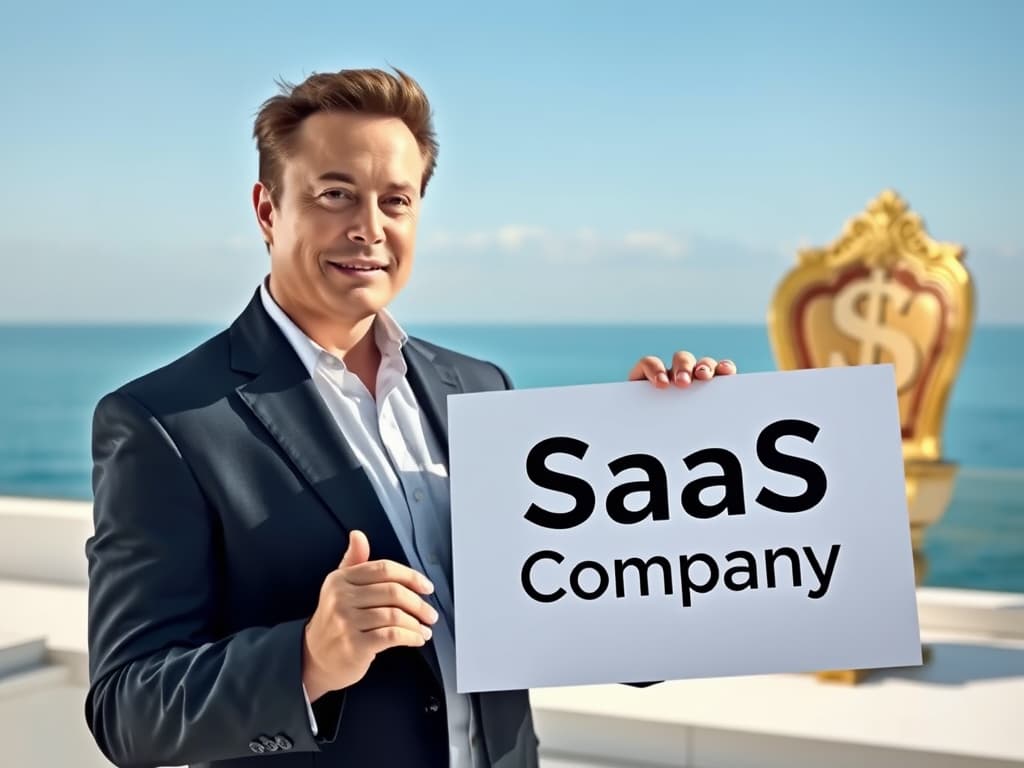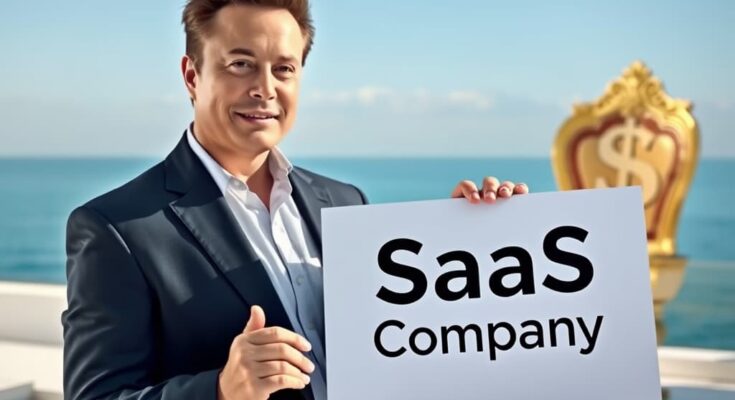Intro
The SaaS industry is booming with revenues projected to hit over $200 billion by 2025. The future is in businesses with recurring revenue and scalable potential, aka SaaS companies. SaaS stands for software as a service. It’s a cloud-based model where users access software over the internet without needing to download it. The best part about creating a SaaS company is that you can build the product once and sell it forever. It’s a very attractive model for entrepreneurs plus it can be run remotely. You can even run your business from the Bahamas if you want to.
You will know the steps that you need to take to launch your own SaaS company and create a recurring and consistent income stream. I’m not just going to show you how to build a business but also how to validate it, market it, and scale it. SaaS companies have a unique advantage in the marketplace with recurring revenue, scalability, and global reach.
So how do you make sure that there are people out there willing to spend money on your product? First, you need to do market research.
Market Research
The most important part of any business is making sure that there is a market for it, which means that people are already spending their money on this thing. The first two questions you must answer before any other question: What problem is your SaaS product solving for people, and who are you solving it for? Go on Google and start researching your competition, the market size, and gather all the data that you can about your industry—such as market growth, who spends the most money on your kind of SaaS software, and what are the emerging trends in the industry.
You can also use a really great software called Frederick AI for this. Rather than wasting thousands of dollars building out a product before you even have a customer base, first build a prototype. An easy way to do this is by building a wireframe.
Build a Prototype
You can draw one with pen and paper, or you can use programs like Balsamiq or Figma to create a digital version. Knowing your desired interface design before working with developers is crucial—that’s why wireframing is essential. This is where your creative genius gets to shine.
Here’s a tip that will save you from pouring money down the drain (and it’s the #1 mistake most startups make): You must validate your business idea. The moment someone pays you is the moment you officially have a business.
Validate Your Idea
Method one: You can start a waitlist to get users to sign up before you build the app. You can incentivize people to share the waitlist by giving them points or discounts to your software. So how can you create a waitlist? You can actually create a waitlist with apps such as Viral Loops and Shopify Forms, or you can even use Google Forms if it’s easier for you.
But here’s the best way to validate your idea: Create an early adopter program. Offer participants a chance to invest in your software by purchasing a license at a discount for the first year. If done successfully, this will prove that people don’t just like your product, they’re willing to pay for it. Name the program and provide exclusive benefits such as a verified status on the platform or involvement in feature creation. Remember, even if people say they like the idea, if people don’t pay, they’re unlikely to spend their money when it’s launched.
I recently listened to an interview with Daniel Priestley who, at the age of 21, launched his first company. It reached $10 million in revenue within 3 years. He says the most important part of starting any company is validating the idea before spending a lot of money. Plus, this looks great to investors or future partners. Okay, what do you do once your idea has been validated? You can create something called an MVP.

Create an MVP
What is an MVP? An MVP is a minimum viable product. You can create an MVP with minimal features to show what your app or software will be like. You can create this using programs like Figma, Bubble, Shopify, or Glide. Here are a few examples of MVPs that big brands started with:
- Buffer, the social media toolkit for small businesses, first launched with a simple landing page just explaining the concept of scheduling social media posts.
- Zapier, the tool that integrates all of your web apps, began as a manual process where the founder literally manually connected apps behind the scenes.
- The founders of Airbnb listed their own apartment on a simple website to test if someone would be willing to pay to stay in someone else’s home.
Now, the much-asked question: How should you price your product? Here are some potential pricing models to consider for your SAS product.
Different Pricing Models
Before you think of your model, I would research what other SaaS products in your space are charging. This way, you can get an idea of the market value. You also want to consider if you have any monthly costs to run your business. Make sure your price reflects what you would need in order to pay off your initial investment within the next few years or months and to cover your monthly costs. Now let’s talk about the different pricing models.
- Subscription-Based Pricing: This is where customers pay a recurring monthly or annual fee to get access to the product. Companies such as Netflix, Shopify, and Spotify all do this very well.
- Premium Model: Offer a basic version of the product for free and then charge for premium features. Cap-Cut and Dropbox both use this model.
- Usage-Based Pricing: This is where customers pay based on how much they actually use the product. Stripe uses this model.
- Flat Rate Pricing: Customers pay one price to get access to all of the features. Notion and Adobe Express do this.
- Per User Pricing: You can charge customers based on how many users there are in their account. Slack and Zoom use this model.
There are many more options, but these are all great. As Patrick Campbell, the founder of Profit-Well, says, “A great pricing strategy doesn’t just maximize revenue, it maximizes your customer’s success.”
The big question: How will your potential customers find you or even know that you exist, and how are you going to make money? Well, marketing will be your best friend in this process.
Marketing
Here are my biggest recommendations when it comes to marketing and selling your products. The nicest thing about SaaS products is that there is no shipping involved, so anybody in the world can access your products immediately at any time.
Partnering with Influencers and Affiliates
First, partner with any key people of influence in your field—influencers, thought leaders, businesses, and groups—and give them free access to your platform in exchange for them to share it if they like it. You can also use affiliate marketing and give influencers a percent of each referral that signs up. You want people to associate your brand with people they trust and respect, plus you’re going to reach a whole new audience this way.
Tools for Finding Partners
You can use Chat-GPT or Google Gemini to help you find these people, and you can also use software such as LinkedIn Sales Navigator or other email finder tools like Apollo that help you get the contact of the exact people you want. Lastly, Shopify Collabs is also a great place to find affiliates.
Next, run paid ads. Chances are a lot of people who need your product are hanging out on social media, and you could target them to sell your product through UGC or just ad creatives in general. To learn more, I actually have a video in the description about TikTok ads and Facebook ads, so go watch those if you need a little extra help.
Next, offer a free trial for new users so that they can test out your app, and once they love it, give you their money. Create educational content on social media focused on your product and build a community around it. Make sure to give as much value as you can.
Next, put good reviews and customer success stories all over your front page. People trust reviews. You can also add your app or software to the Shopify App Store if your SAS software serves businesses. Now, what will you need to create a SAS product? You will need to find a team.
Team
Developer to build out the software and a UI or UX designer for your interface. You may potentially need a DevOps engineer, product managers, and customer service representatives. You can actually find the right people for this on platforms such as Toptal, which actually have the top 3% of talent, Wellfound, which is made for startups, or Gun.io, specifically made to find software talent. For sales, you can hire a sales team on a percentage basis or you can just do sales on your own. You honestly do not need a big team to start. You may need to do everything on your own in the beginning.
The biggest thing you need is to outsource product development. You can also partner with developers to get up and running, but be careful who you give your equity to. Believe it or not, you can actually build SaaS software with no-code apps such as Bubble, Glide, or Adalo, so go give those ones a try. The downside is that you don’t fully own the software because it is run on their platform, so if something happens to them, you may not have a software anymore.
Here are a few more AI tools to help you. You can build an app on Firebase, you can use Maxio for billing, and lastly, you can use FullStory for behavioral data.
What is the best way to keep customers happy? Make sure to provide ongoing customer support.
Customer Support
Always, always keep your software up to date and iron out any bugs in the system. You want to make sure your product is actually solving your customer’s problem. You will also want to monitor and respond to customer feedback. The goal is to keep people on the platform for as long as you can. We always want to be thinking about the future of our business. You want to make sure that your scaling processes are scalable.
Scaling
So here are some ways you can scale your business. The whole point of scaling is doing more of what is working. So use something called the 80/20 rule. The 80/20 rule states that 80% of your results come from 20% of what you do, and 20% of your results come from 80% of what you do. So narrow down what’s actually working for you and do more of it.
For example, if you’re getting most of your customers from ads, put more money into pushing ads. If most of your revenue is coming from paid feature upgrades, build more of those for customers to buy. You get the gist.
Here are a few standard things you can do to scale once you have customer data: Refine your target customer and retarget them with ads. You can also upsell your customers. Solve the problems they face before, during, and after using your products and then charge them for it. You want to expand your market and start selling to new locations or even adapt your product to meet the needs of adjacent industries. You can also build a sales team around your product or even automate your current processes.
Another thing you can do is raise additional funding to pour into your business, but most importantly, pour your money into the places where money is already pouring out for you.
Now I want to hear from you guys. What SaaS products are you currently excited about? Comment them down below. Look, no one is going to become an entrepreneur without facing some challenges. These are the common challenges you will likely face in the SaaS industry, but you’ve got this, guys. Rome was not built in a day.
Challenges
Okay, first is churn rates. A churn rate is the percentage of customers that stop using your services within a given time frame. Churn rate percent equals the total number of customers lost during a period of time divided by the total number of customers at the start of the period, and then you times it by 100. You now have your churn rate percent.
For example, if a company starts with 1,000 customers at the beginning of the month and loses 50, their churn rate is 5%. Just so you know, the typical SaaS churn rate is 5%. So if customers are running away a little too fast and you have a higher churn rate, make sure to check in on what might be causing it and improve those areas. You can also run a survey to ask people why they left.
Competition: There will always be competitors in the ring, but that’s kind of what makes life fun. It’s a challenge. Other competitors may lower their prices, steal your features and improve on them, or even steal your customers. So pay attention to what your customers are asking for and always keep your features up to date. This way, you can stand out in a saturated market.
Let’s talk about the future of SaaS. There are a lot of new trends in the SaaS space.
New Trends
The biggest one we all know of is AI, but there’s a lot of other cool products like data as a service, platform as a service, and market consolidation. Big companies are actually acquiring smaller companies in their space, so it could be a good strategy to build a SaaS company and then sell it to a bigger player.
Micro-SaaS Companies
Another trend is micro-SaaS companies. These are operating on a much smaller scale. The last one I will mention is white-label SaaS. This is where you can purchase unbranded SaaS software and just put your brand on it.
Anybody can become a successful entrepreneur. It is not the smartest people in the room who do it, but just the ones who believe in themselves enough and are willing to learn and take action. You now know how to start a SaaS company.
Building Resilience
The biggest thing you can work on as an entrepreneur is your mindset. Everything you do stems from your belief system, so make sure you’re feeding your brain with thought food that fuels your entrepreneurial journey. It will not be easy. You’re probably going to be challenged more than you ever have been, but there’s a quote that I really resonate with: “Being an entrepreneur means doing the known work for the unknown outcome.” You don’t know what your results will be until you try, but the best thing you can do is take action and do the work. You know what you need to do.
The other most important thing is speed. Make sure you’re taking action quickly. Ideas can ruminate in our heads for years and never make it out of our minds, so go get out there and build a killer SaaS product. I cannot wait to see what you guys create. And if you want to get access to a bunch of free resources for all things business, Go Ahead!



